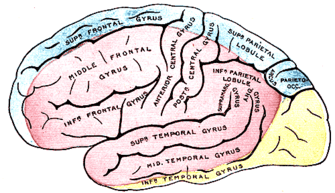Anterior cerebral artery syndrome
| Anterior cerebral artery syndrome | |
|---|---|
|
Outer surface of cerebral hemisphere, showing areas supplied by cerebral arteries. (Blue is region supplied by anterior cerebral artery.) | |
| Classification and external resources | |
| Specialty | neurology |
| ICD-10 | G46.1 |
| MeSH | D020243 |
Anterior cerebral artery syndrome is a condition whereby the blood supply from the anterior cerebral artery (ACA) is restricted, leading to a reduction of the function of the portions of the brain supplied by that vessel: the medial aspects of the frontal and parietal lobes, basal ganglia, anterior fornix and anterior corpus callosum.[1]
Depending upon the area and severity of the occlusion, signs and symptoms may vary within the population affected with ACA syndrome. Blockages to the proximal (A1) segment of the vessel produce only minor deficits due to the collateral blood flow from the opposite hemisphere via the anterior communicating artery. Occlusions distal to this segment will result in more severe presentation of ACA syndrome. Contralateral hemiparesis and hemisensory loss of the lower extremity is the most common symptom associated with ACA syndrome.[1]
Signs and symptoms
- Hemiparesis or hemiplegia contralaterally, involving primarily the lower limbs and pelvic floor musculature
- Sensory deficits contralaterally, involving primarily the leg and perineum
- Apraxia (due to branches to the supplementary motor area and corpus callosum)[1]
- Disconnection syndrome (due to callosal branches)
- Anosmia (due to branches of the olfactory bulb and olfactory tract)
- Urinary incontinence[1]
- Grasp reflex and or sucking reflex contralaterally (if circle of Willis compromised)[1]
